Flagella is the motility organelle of the bacteria.
Introduction:
Flagella is known as motility or locomotor organelle and it looks hair like appendage. They are longer than pilli and fimbriae. Their structure is rigid and slender. The bacteria are able to swim in liquid media is due to the rotating movement of flagella. To perceive the flagellar movement, it is necessary to understand the structure of flagella.
Structure of Flagella –
The flagellum is composed of three parts –filament, basal body and hook. The filament is the longest portion that looks like hair, extended from plasma membrane and made up from the flagellin protein. The filament is connected to basal body by the hook. The basal body consists of different rings that acts like clamp and allow it to get fixed in cell wall and cytoplasmic membrane. The proteins associated with basal body acts like motor and provide energy for flagellar movement. Such proteins are called as Mot proteins (mot A and mot B). To regulate the action of motor protein, Fli proteins are employed and they acts like switches.
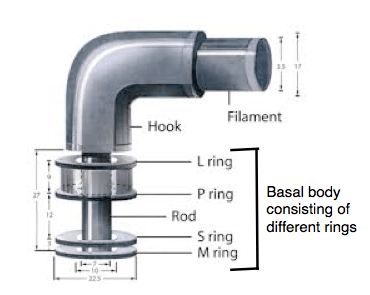
The gram positive and gram negative bacteria differ in the composition and structure of cell wall. And hence, the basal body of flagella which is embedded in cell wall and plasma membrane also differs in gram positive and gram negative bacteria. The flagella of gram negative bacteria have four rings L, P, MS and they are embedded in cell wall and membrane whereas the C ring is present at the cytoplasmic side. It is made from FliG, FliM and FliN. The Gram-positive bacteria have only two rings, one is connected to peptidoglycan and other is connected to plasma membrane. These rings acts like bearing to this motor protein.
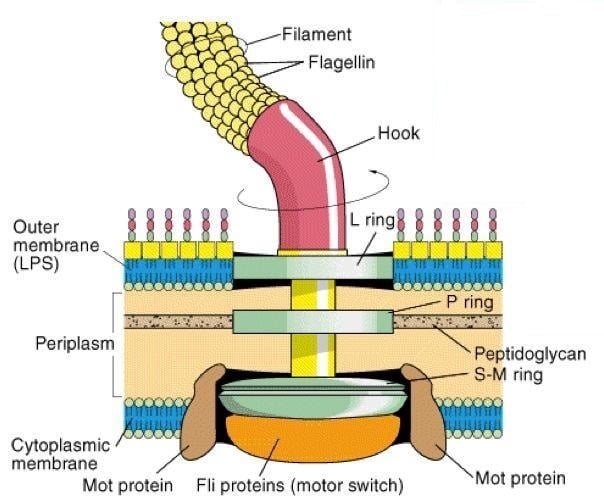
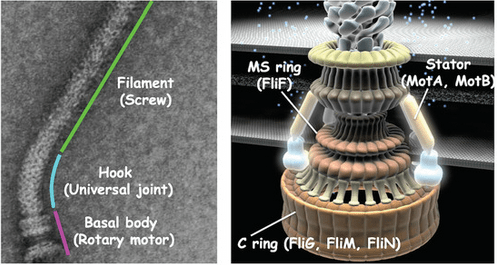
The motor of flagella has two components – rotor and stator (just like a mechanical machine). The rotor rotates and Stator remains stationary. In gram negative bacteria, the rotor is made from MS and C ring protein whereas Mot A and Mot B acts as stator. Mot A and Mot B forms a channel in plasma membrane. The FliG protein of C ring interacts with stator. The energy that is required for working of motor is generated by proton gradient mechanism. This mechanism is similar that you have studied in Electron transport chain, where electrons is transferred from one to another in a chain and during this process the protons are pumped out. This forms the difference in H+ ions concentration across the plasma membrane forming proton gradient. In flagellar movement, the channel formed by mot A and B is used for movement of proton from higher to lower concentration. This movement of proton ion generates the energy.

Based on the number and location of flagella, they are divided as Monotrichous, Amphitrichou,s lophotrichous and peritrichous. Monotrichous bacteria (trichous means hair), have one flagellum; if it is located at an end, it is said to be a polar flagellum. Amphitrichous bacteria (amphi means “on both sides”) have a single flagellum at each pole. In contrast, lophotrichous bacteria (lopho means tuft) have a cluster of flagella at one or both ends. Flagella are spread fairly evenly over the whole surface of peritrichous (peri means “around”) bacteria. Flagellation patterns are very useful in identifying bacteria. Bacteria without flagella are called as atrichous.
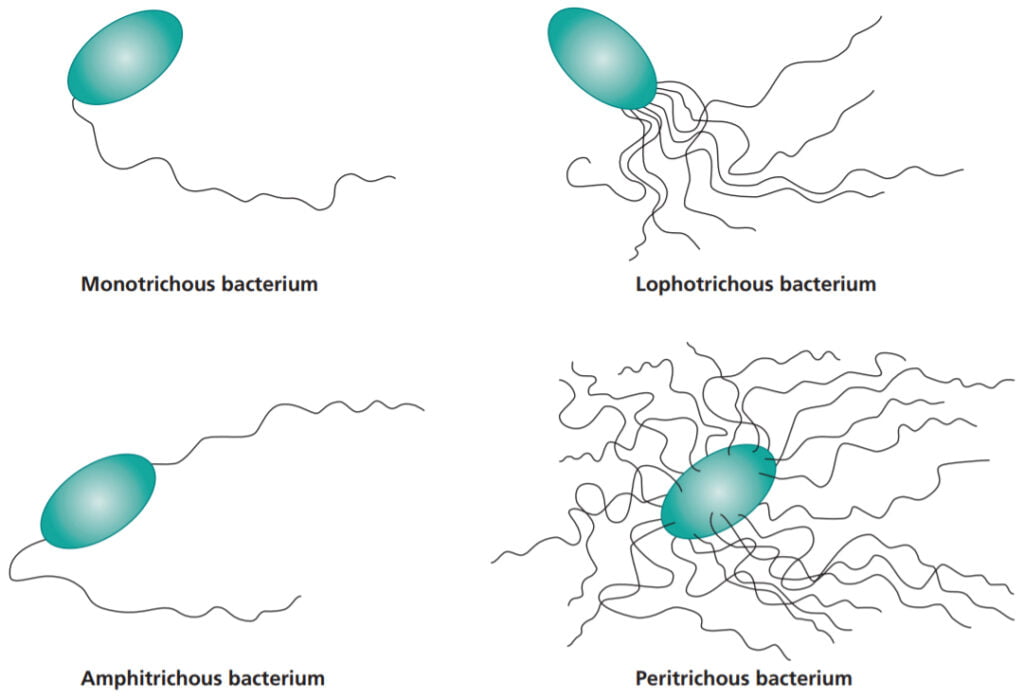
Difference and similarity between Flagella and cilia –
Flagella and cilia are the motility organelle. They both look like hair-like structures and show whip-like movement making the microorganism move. Cilia are much smaller than flagella. Cilia’s size ranges from 5 to 20 um and flagella size ranges from 100 to 200 um. While whipping movement, the flagella and cilia generate helical or planar waves. When these waves originate from the base, the cell moves forward. Whereas, when the wave originates from the tip it pulls the cell back. Flagella may have lateral hair on its surface called mastigonemes. These mastigonemes are involved in changing the flagellar action. Suppose, if the wave is moving from base to tip, the flagella should move forward but instead mastigonemes pull the cell back. The cilia works like boat oars that stroke and propel the microorganism in the water.
Though the mechanism of movement is different but cilia and flagella have very similar ultrastructure. They are made of nine pairs of microtubules called axoneme. The 9 pairs of microtubule doublets are arranged in the circle around two central tubules. Such an arrangement is called the 9+2 pattern. The individual microtubules of the doublet have been named as subtubule A and B. In the doublet, subtubule A projects its two arms towards the neighbouring doublet. Subtubule A also projects a radial stroke towards the central sheath.
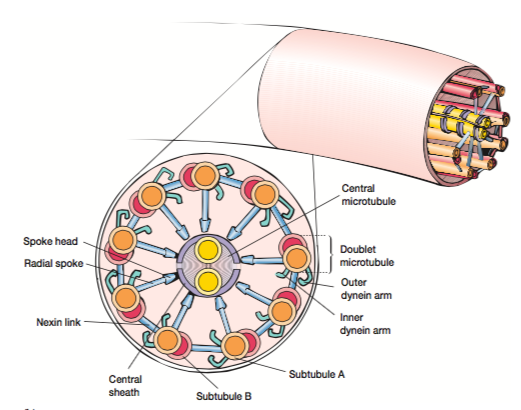
Chemotaxis
Flagella allow bacteria to show chemotaxis. Chemotaxis is a sensory phenomena of bacteria which directs the movement of bacteria. It is the movement of bacteria towards attractant and away from repellent. The sensing of attractant or nutrient and repellent or toxin is carried by chemoreceptors.
Chemotaxis revealed that the bacteria not always swin aimlessly but rather they move in specific direction as per the need. Scientist have demonstrated the movement of bacteria in the chemical gradient suspension. The sensory system is very sensitive to the concentrations of attractants and repellents. The bacteria senses the chemicals with the help of chemoreceptors, made up from special proteins. The chemoreceptors works like a transmitter, that sense the chemical and transmit the message. The chemoreceptors are located in plasma membrane and periplasmic space.
Bacteria move randomly in the absence of any chemical, it runs and tumble from time to time. But in presence of a chemical, bacterium tumble less and runs more. In case of Escherichia coli, when flagella rotates in counterclockwise the bacteria moves in the forward direction or runs. However, the clockwise movement of flagella cause bacteria to tumble.
The chemoreceptors are regulated at molecular level. The chemoreceptors consists of CheA, CheY and FliM proteins that shows cascade of reaction on interacting with nutrient. When Chemorectors interact or come in contact with nutrient, ATP phosphorylate CheA protein, the activate CheA protein donates its phosphate group to CheY protein. The activated CheY protein commune with FliM protein which acts like a switch and it is present as the base of the flagellum. The FliM cause and promote the flagellar movement in the anticlockwise direction enabling bacteria to run. When bacteria is not around any nutrient or chemoattractant, it maintains less phosphorylated CheA and CheY, allowing to bacteria to show walk like movement.
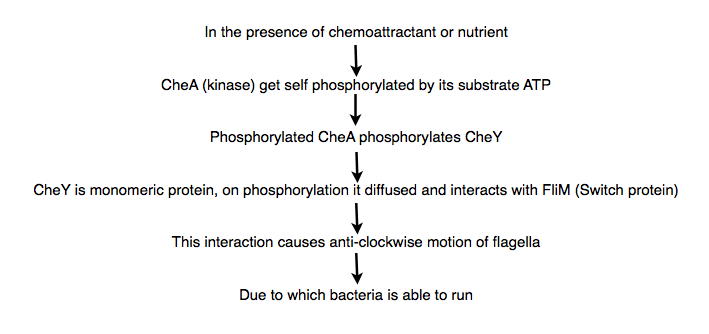
To understand more in detail, Watch this video
References:
https://www.mdpi.com/2218-273X/9/7/279
http://www.bioinfo.org.cn/book/biochemistry/chapt18/bio6.htm
Dr. Sangha Bijekar has 9 years of Teaching Experience at University level. She loves to get engage in teaching and learning process. She is into blogging from last two years. She intends to provide student friendly reading material. She is avid Dog Lover and animal rescuer. She is learned Bharatnatyam and Katthak Dancer. She is into biking and She also loves to cook.

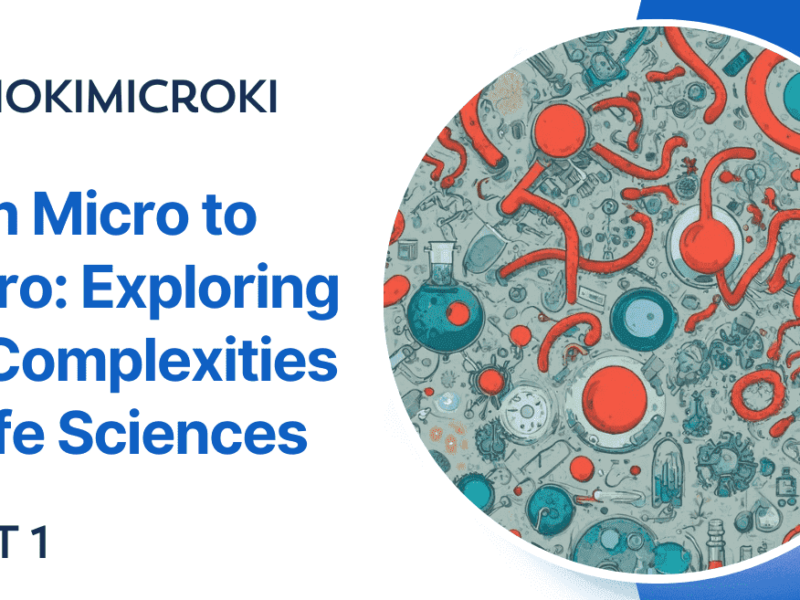
One thought on “Bacterial Flagella, its types and Chemotaxis”